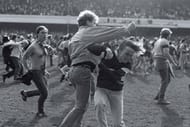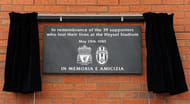Passionate fans help make football the unique sport that it is. And that passion does not stop once the final whistle blows; it is something lived and professed throughout one’s life. However, obsessive fondness for the game comes at a great price. Fanaticism, in many areas of the world, unfortunately spills into violence.
At the worst of times, the price of passion is often paid in the form of loss of life and property. In fact, if stats are anything to go by, football has resulted in more violence related injuries and deaths than any other sport in the world.
Background
Although football hooliganism rose to widespread public attention only around the 1960s, chaotic and disorderly behavior has been common amongst football supporters ever since the birth of the sport. During football’s blooming years, around the 19th century, concerns were frequently voiced about a group of ‘roughs’ causing regular trouble at matches by attacking not only the opposition supporters, but also the players and officials.
Football became more respectable during the inter-war period and although it wasn’t totally wiped out, violence considerably declined. It wasn’t until the early 1960s that hooliganism became a serious issue again.
Football stadiums began to be recognized as public places where large scale dangerous rituals and fights could be staged. Loose alliances were formed amongst young men on match days, and they occupied the terraces behind the goals at stadiums. A large network of rival gangs was built and fights became a normal sight. It was at this time that football hooliganism began to take shape in the form that it is seen today.
The horror of Heysel
In the 1980s, hooliganism began to be indelibly associated with English football following a series of major disturbances home and abroad. A watershed moment in the history of English football hooliganism was the Heysel disaster of 1985.
There has been no spectacle in the history of televised sport as compelling and atrocious as that on 29 May 1985, in which a ‘charge’ by Liverpool supporters at rival Juventus fans caused a wall to collapse at the decaying Heysel Athletics Stadium in Brussels, resulting in 39 deaths.
A game billed to be a carnival of attacking football, ended up being a scene of carnage. Blood sprawled all over the place and the stadium wore a deserted look as the most important match in the European calendar was held in crumbling ruin. This was a scene from a football match and not a war, but you wouldn’t be able to tell that.
In the aftermath of the Heysel tragedy, numerous measures were sought, and substantial efforts were put in by the police and the football clubs alike to bring the situation under control. The Football Spectators Act tried to address the more pressing issues by suggesting the compulsory distribution of identity cards to spectators attending any football match being played in England and Wales, in the hope of identifying known hooligans and preventing them from entering the stadium.
Earlier that year, the Kenilworth Road riot saw Millwall fans climb out of the away terrace and storm the sections of Luton fans, ripping up seats and hurling them at the home supporters. Luton banned away fans for the next four seasons.
These incidents, involving small groups of people, had the effect of tarnishing all fans and often led to them being treated like a cross between thugs and cattle.
While the ID card scheme turned out to be an overall failure, there were other certain other areas that did start showing changes. In the wake of the tragedy, clubs from England were subsequently banned from participating in any European competition for the next five years, with Liverpool being handed a double penalty (which was later lifted to six years). The ban was a major blow to English football considering their recent success and domination in Europe.
Whether the ban made any significant impact on changing fan culture in football is debatable, but it can’t be denied that there have been fewer number of incidents following the sanctions. So even though efforts such as the identity card scheme or the ban may or may not have made any immediate difference, things certainly changed for the better following Heysel.
Current scenario – The European invasion

In most European countries, football-related violence is currently a predominantly internal problem, with the majority of incidents occurring at club-level matches, while supporters of the national team abroad are generally better-behaved. Internally, however, fans tend to cause more trouble at 'away' matches than when supporting their team at home.
This is a common pattern across Europe. While some European Hooligan Unions do tend to regard their English counterparts as their role models, others including Scotland’s famous ‘Tartan Army’ and the Danish Roligans, have quite deliberately adopted a very different style of behaviour.
Football hooliganism is clearly not an exclusively 'British disease'. Nor can the British hooligans be held entirely responsible for 'spreading' the disease in Europe.
Emerging role of media
Football violence is a highly visible phenomenon as television broadcasters and journalists are present at almost every single match, reporting on the crowd behaviour as much as on the match itself. As a result, the chances of a story being missed are rather slim. Media coverage of such events is extensive and the British tabloid press in particular devotes a number of pages to any incident that occurs, put together with numerous ‘sensationalist’ headlines.
Many researchers, over the years, have argued that this sensationalism actually contributes to the problem. The hooligans tend to relish the coverage they receive, often positively looking at it as a ‘victory’ over their rival gangs.
The importance of media was recently put forth in a European Parliament Report on football hooliganism, which strongly recommended the promotion of free and fair sporting ethics, with particular emphasis on avoiding dramatism and sensationalism.
Conclusion
Now the main question: how to tackle this serious problem, considering that several measures on the part of the police and the sporting bodies have fallen flat? In my view, kicking hooliganism out of football not only requires cooperative action from regional, national and international football governing bodies, but also a legal framework in which law and order be maintained and civilized behaviour be encouraged for the good of the game.
Perhaps ironically, one of the most significant factors in reducing the problem of hooliganism has been the widening of the sport and of course the huge influx of money.
There is a need to treat the causes of football hooliganism rather than the symptoms and, by extension, to pay particular attention to the implications of imposing restrictions on the freedom of actual and potential football hooligans. The balance between the two remains very crucial.




